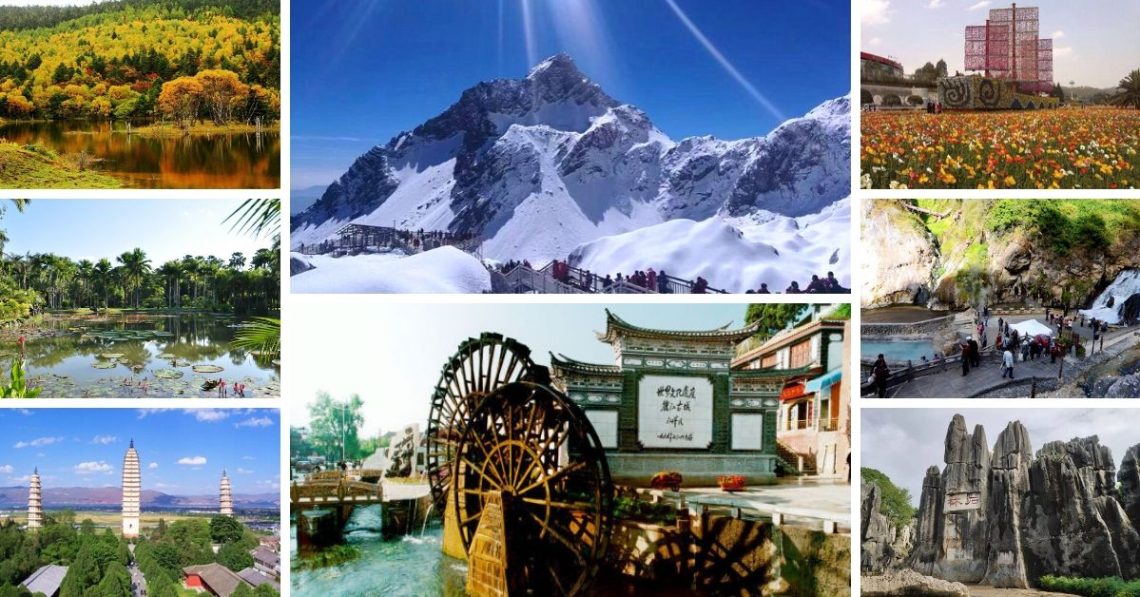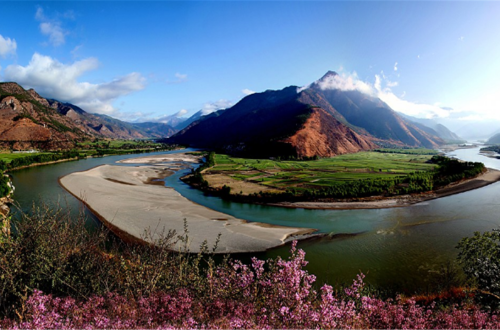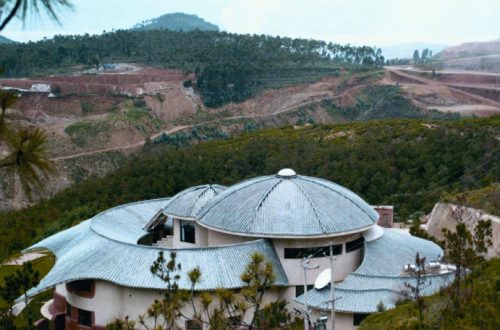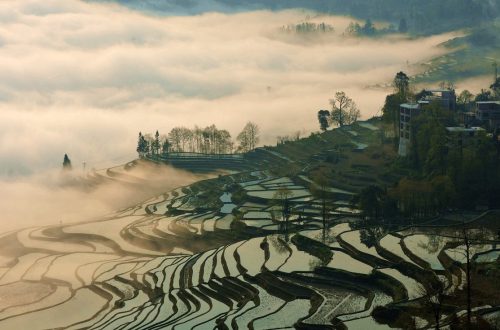Yunnan Province is located in China’s southwest with Kunming serving as the capital of the province. It is adjacent to Guizhou and Guangxi in the east, Sichuan in the north, Tibet in the northwest. It has an international border with Myanmar in the west and Laos and Vietnam in the south.
The total area of Yunnan Province is 394,100 square kilometers. As of August 2019, Yunnan Province has 8 prefecture-level cities, 8 autonomous prefectures, which are subdivided into 129 county-level divisions. See Cities and Counties further below.
In 2018, the resident population of Yunnan Province was 48.295 million, with a total production value of 1.7881 trillion yuan, the added value of the primary industry was 249.886 billion yuan, the added value of the secondary industry was 695.744 billion yuan, and the added value of the tertiary industry was 842.482 billion yuan. The per capita GDP 37,136 yuan.
Climate
The climate of Yunnan belongs to the subtropical plateau monsoon type.
The northwestern part of Yunnan has a cold-zone climate, with no winter in summer and short spring and autumn. The eastern part of Yunnan and eastern Yunnan have a temperate climate. The southwest and southwestern Yunnan belong to the low-heat valley, and some are in the Tropic of Cancer. To the south, into the tropics, there is no winter in the summer, and it rains into the autumn. In the province, there are three climates of cold, warm and hot (including subtropical).
The average temperature in the province, the hottest (July) monthly average temperature is between 19 °C and 22 °C, the coldest (January) monthly average temperature is above 6 °C ~ 8 °C, the annual temperature difference is generally only 10 ° C ~ 12 ° C. It is cooler in the morning and evening, and hotter at noon, especially in winter and spring. The daily temperature difference can reach 12 °C ~ 20 °C. The province has a long frost-free period. The southern border has no frost all year round. The frost-free period in the south is 300-330 days, and the central region is about 250 days.
The wet season (rainy season) is from May to October, with 85% of rainfall concentrated; the dry season (dry season) is from November to April, and precipitation accounts for only 15% of the year. The geographical distribution of precipitation differs greatly.
Wildlife
Yunnan has the highest number of animal species in the country. There are 1,737 vertebrates, accounting for 58.9% of the country. Among them, 793 species of birds, accounting for 63.7%; 300 species of mammals, accounting for 51.1%; 366 species of fish, accounting for 45.7%; 143 species of reptiles, accounting for 37.6%; 102 species of amphibians, accounting for 46.4%.
There are many rare and protected animals in Yunnan, and many animals are only found in Yunnan.
Ethnic Groups
Yunnan is the province with the largest ethnic group in China. In addition to the Han nationality, there are 25 ethnic minorities with a population of over 6,000. Among them, 15 ethnic groups are unique to Yunnan, and the population accounts for more than 80% of the total ethnic population of the country.
At the end of 2015, the number of ethnic minorities in the province reached 15.83 million, accounting for 33.4% of the province’s total population. It is one of the three provinces with a minority population of more than 10 million. There are 6 ethnic minorities with a population of more than 1 million in the province; 9 with less than 100,000 and less than 1 million; 8 with less than 10,000 and less than 100,000; and more than 6,000 with less than 10,000. The ethnic minorities in Yunnan are interlaced, showing large mixed habitats and small settlements.
Ethnic groups include the Yi, Bai, Hani, Tai, Dai, Miao, Lisu, Hui, Lahu, Wa, Nakhi, Yao, Tibetans, Jingpo, Blang, Pumi, Nu, Achang, Jinuo, Mongols, Derung, Manchus, Sui, and Buyei.
Language
Yunnan is a multi-ethnic province with rich and colorful languages. The Han language of Yunnan belongs to the Northern Languages (Southwest Mandarin). The languages of other ethnic groups belong to the Sino-Tibetan and South Asian languages. In addition to the common Chinese language of Hui, Manchu and Shui, all the ethnic groups in Yunnan have their own language, and 22 ethnic scripts are used. Among them, the Yi language language has a certain historical origin with Thailand. The Naxi people have a long history of Dongba culture, and the Dongba script is a hieroglyph that is still inherited.
Industry
The largest pillar industry in Yunnan is the tobacco industry. The sugar industry and the tea industry are traditional backbone industries other than smoke in Yunnan. The rubber planting industry is an important traditional industry in Yunnan. The flower industry is an emerging industry in Yunnan and a key province for sugar, tea and rubber. It is also Asia’s largest fresh cut flower export base.
GDP
Review In 2018, Yunnan Province achieved a total production value of 1,788.112 billion yuan, 8.9% over the previous year. Among them, the added value of the primary industry was 249.886 billion yuan, up 6.3%; the added value of the secondary industry was 695.744 billion yuan, up 11.3%; the added value of the tertiary industry was 842.482 billion yuan, up 7.6%. The three industrial structures were adjusted to 14.0:38.9:47.1. The province’s per capita GDP was 37,136 yuan, an increase of 8.2% over the previous year.
In 2018, the per capita disposable income of Yunnan residents was 20084 yuan, an increase of 9.5% over the previous year. The per capita disposable income of urban residents was 33,488 yuan, an increase of 8.0%; the per capita disposable income of rural permanent residents was 10,768 yuan, an increase of 9.2%. The per capita consumption expenditure of urban residents was 21,626 yuan, an increase of 10.6%. The per capita living expenditure of rural residents was 9,123 yuan, an increase of 13.6%.
Airports
As of 2018, Yunnan Province has operated 15 civil transport airports, with Kunming Changshui International Airport as the core, and 14 other trunk feeder airports as the supporting airport network system. The province’s passenger throughput exceeds 1 million passengers.
Main airports
- Kunming Changshui International Airport 昆明长水国际机场
- Lijiang Sanyi International Airport 丽江三义国际机场
- Xishuangbanna Gasa International Airport 西双版纳嘎洒国际机场
- Diqing Shangri-La Airport 迪庆香格里拉机场
- Dali Airport 大理荒草坝机场
- Zhaotong Airport 昭通机场
- Wuhu Airport 泸沽湖机场
- Pu’er Simao Airport 普洱思茅机场
- Baoshan Yunrui Airport 保山云瑞机场
- Linyi Airport 临沧机场
- Wenshan Puzhehei Airport 文山普者黑机场
- Tengchong Hump Airport 腾冲驼峰机场
- Dehong Mangshi Airport 德宏芒市机场
- Wuyuan Airport 沧源机场
Rail
By the end of 2018, Yunnan’s railway operation mileage was 3,848 kilometers, including 1,026 kilometers of high-speed rail, and 9 cities were connected to the railway, of which 7 were high-speed rail. There are 8 railway projects under construction, 4 of which are scheduled to be completed and operated by the end of 2020.
The major High Speed Rail Stations in Yunnan are Kunming Railway Station, Chuxiong Railway Station, Dali Railway Station, and Lijiang Railway Station.
Ports
There are 5 main rivers and their tributaries in Jinsha River, Minjiang River, Honghe River, Nanpan River and Nujiang River, with a total length of 14,200 kilometers. Among them, there are more than 8,000 kilometers of waterways that can be developed and utilized, and there are more than 30 plateau lakes and 5,500 reservoirs of various types.
Main ports: Jinghong Port, Simao Port, Shuifu Port, Qijiang Port, Kunming Port, Dali Port.
Attractions
Yunnan is typified by karst caves, virgin forests, flowers, cultural relics, traditional gardens, and ethnic customs. There are more than 200 scenic spots in the province, and there are 134 scenic spots above the national level A, including 12 national scenic spots and 53 provincial-level scenic spots. There are 6 national historical and cultural cities, 11 provincial-level historical and cultural cities, 6 national historical and cultural towns, 14 provincial-level historical and cultural towns, and 14 provincial-level historical and cultural villages.
AAAAA Attractions

Potatso National Park (普达措国家公园)

Stone Forest (昆明市石林风景区)

Jade Dragon Snow Mountain (玉龙雪山)

Three Pagodas (崇圣寺三塔)

Xishuangbanna Tropical Botanical Garden (中国科学院西双版纳热带植物园)

Old Town of Lijiang (丽江古城)

World Horti-Expo Garden (世界园艺博览园)

Tengchong Volcanic Scenic Area (腾冲热海风景区)
AAAA Attractions in Yunnan Province
| City | Scenic spot name | CN name |
|
Kunming City 昆明市
|
Jiuxiang Scenic Area | 九乡风景名胜区 |
| Yunnan Ethnic Village | 云南民族村 | |
| Kunming Xishan Forest Park | 昆明西山森林公园 | |
| Kunming Grand View Park | 昆明大观公园 | |
| Kunming Golden Temple Scenic Area | 昆明金殿景区 | |
| Kunming Guandu Ancient Town | 昆明官渡古镇 | |
| Yunnan Wildlife Park | 云南野生动物园 | |
| Kunming Colorful Yunnan Scenic Area | 昆明七彩云南景区 | |
| Kunming Jiaozishan | 昆明轿子山 | |
|
Qujing City 曲靖市 |
Luliang Color Shalin Scenic Area | 陆良彩色沙林景区 |
| Luoping Jiulong Waterfall Group Scenic Area | 罗平九龙瀑布群景区 | |
| Zhanyi Pearl River Source Scenic Area | 沾益珠江源景区 | |
| Shizong Phoenix Valley Life and Culture Theme Park | 师宗凤凰谷生命文化主题公园 | |
| Huize County Sea Grass Mountain View | 会泽县大海草山景 | |
| Qujing Shizong Fungi Mountain | 曲靖师宗菌子山 | |
|
Yuxi City 玉溪市 |
Tonghai Xiushan Park | 通海秀山公园 |
| Yuxi Yingyuetan Leisure Culture Center | 玉溪映月潭休闲文化中心 | |
| Yuxi Huilong Ecological Park | 玉溪汇龙生态园 | |
| Chengjiang Luchong Scenic Area | 澄江禄充景区 | |
| Baoshan City 保山市 | Tengchong and Shunjing District | 腾冲和顺景区 |
|
Chuxiong Prefecture 楚雄州 |
Lufeng World Dinosaur Valley Scenic Area | 禄丰世界恐龙谷景区 |
| Chuxiong Yiren Ancient Town | 楚雄彝人古镇 | |
| Yuanmou Tulin Scenic Area | 元谋土林景区 | |
| Wuding Lion Mountain Scenic Area | 武定狮子山景区 | |
| Chuxiong State Museum | 楚雄州博物馆 | |
| Chuxiong Zixi Mountain | 楚雄紫溪山 | |
|
Honghe Prefecture 红河州 |
Aogu Ancient Cave Scenic Spot | 泸西阿庐古洞景区 |
| Jianshui Swallow Cave Scenic Area | 建水燕子洞风景名胜区 | |
| Jianshui Confucian Temple | 建水文庙 | |
| Maitreya Spring Ecological Park Scenic Area | 弥勒湖泉生态园景区 | |
| Yuanyang Hani Terraced Field Scenic Area | 元阳哈尼梯田景区 | |
| Jianshui Tuanshan Ancient Village Scenic Area | 建水团山古村景区 | |
| Jianshui Zhujia Garden Scenic Area | 建水朱家花园景区 | |
| Wenshan Prefecture 文山州 | Qiubei Puzhe Black Scenic Area | 丘北普者黑景区 |
|
Pu’er City 普洱市 |
Pu’er National Park | 普洱国家公园 |
| Pu’er Ximeng Suspension Longtan Scenic Area | 普洱西盟勐梭龙潭景区 | |
| Pu’er Tianshili Dibo Bio-Coffee Valley | 普洱天士力帝泊洱生物茶谷 | |
|
Xishuangbanna 西双版纳州 |
Xishuangbanna Dai Nationality Park | 西双版纳傣族园 |
| Xishuangbanna Primeval Forest Park | 西双版纳原始森林公园 | |
| Xishuangbanna Tropical Flower Garden | 西双版纳热带花卉园 | |
| Xishuangbanna Wild Elephant Valley Scenic Area | 西双版纳野象谷景区 | |
| Jing Hong Man listening to the park | 景洪曼听公园 | |
| Xishuangbanna Wangtianshu Scenic Area | 西双版纳望天树景区 | |
| Xishuangbanna Dai Buddha Temple | 西双版纳勐泐大佛寺 | |
| Xishuangbanna Tea Horse Road Scenic Area | 西双版纳茶马古道景区 | |
| Xishuangbanna Yujinglai Scenic Area | 西双版纳勐景来景区 | |
| Xishuangbanna, Zhaozhuang, Xishuangjing | 西双版纳告庄西双景 | |
|
Dali Prefecture 大理州 |
Dali Nanxun Fengqing Island | 大理南诏风情岛 |
| Binchuan Chicken Foot Mountain Scenic Area | 宾川鸡足山景区 | |
| Heqing Yindu Water Town Xinhua Village Scenic Area | 鹤庆银都水乡新华村景区 | |
| Jianchuan Shibaoshan·Shaxi Ancient Town Tourist Area | 剑川石宝山·沙溪古镇旅游区 | |
| Dali Ancient City | 大理古城 | |
| Xiangyun Shuimu Mountain Cultural Tourism Area | 祥云水目山文化旅游区 | |
| Dali Laoshan Ancient City – Yubaoshan Tourist Area | 大理巍山古城—巍宝山旅游区 | |
| Dali Butterfly Springs Park | 大理蝴蝶泉公园 | |
|
Dehong Prefecture 德宏州
|
Lianghe Nandian Xuanfu Department | 梁河南甸宣抚司署 |
| Mangshi Bana Xi Zhenqi Garden | 芒市勐巴娜西珍奇园 | |
|
Lijiang City 丽江市 |
Lijiang Yushui Village Scenic Area | 丽江玉水寨景区 |
| Ninglang Lake Scenic Area | 宁蒗泸沽湖景区 | |
| Lijiang Shuhe Ancient Town Scenic Area | 丽江束河古镇景区 | |
| Lijiang Black Dragon Pool Scenic Area | 丽江黑龙潭景区 | |
| Lijiang Guanyinxia Scenic Area | 丽江观音峡景区 | |
| Lijiang Dongba Valley Scenic Area | 丽江东巴谷景区 | |
| Lijiang Laojun Mountain National Park Dawn Scenic Area | 丽江老君山国家公园黎明景区 | |
|
Diqing 迪庆州 |
Deqin Meili Snow Mountain Scenic Area | 德钦梅里雪山景区 |
| Shangri-La Tiger Leaping Gorge Scenic Area | 香格里拉虎跳峡景区 | |
| Shangri-La Grand Canyon Balaguezong Scenic Area | 香格里拉大峡谷巴拉格宗景区 | |
| Diqing Shangri-La Songzanlin Temple Scenic Area | 迪庆香格里拉松赞林寺景区 | |
| Diqing Shangri-La Blue Moon Valley Scenic Area | 迪庆香格里拉蓝月山谷景区 | |
| Zhaotong City 昭通市 | Shuifu West Grand Canyon Hot Springs Tourist Area | 水富西部大峡谷温泉旅游区 |
Yunnan Cuisine
Yunnan cuisine is known as Dian cuisine (滇美食). It is predominantly spicy but varied and diverse due to the mix of ethnicities. It is also one of only two provinces featuring a traditional cheese which is made by the Bai people and known as Rushan (乳扇) and made from cows milk, and Rubing (乳饼) when made from goats milk.
Popular dishes include Crossing Bridge Noodles (过桥米线) whose common ingredients include thin slices of ham, chunks of chicken, chicken skin, strips of bean curd sheets, chives, sprouts, and rice noodles. Other popular dishes include Steam Pot Chicken (气锅鸡), Yiliang roast duck (宜良烤鸭), and Jidou liangfen (鸡豆凉粉) which is a type of jelly made from ground chickpea or lentils.
The area is also, of course, famous for Pu’er tea and in modern times coffee production.
Cities and Counties
Administrative divisions
| Admin Division | Area in km sq | Population | Seat |
|---|---|---|---|
| Yunnan Province | 394000 | 45,966,766 | Kunming city |
| Kunming city | 21,001.28 | 6,432,209 | Chenggong District |
| Qujing city | 28,939.41 | 5,855,055 | Qilin District |
| Yuxi city | 14,941.53 | 2,303,518 | Hongta District |
| Baoshan city | 19,064.60 | 2,506,491 | Longyang District |
| Zhaotong city | 22,439.76 | 5,213,521 | Zhaoyang District |
| Lijiang city | 20,557.25 | 1,244,769 | Gucheng District |
| Pu’er city | 44,264.79 | 2,542,898 | Simao District |
| Lincang city | 23,620.72 | 2,429,497 | Linxiang District |
| Chuxiong Autonomous Prefecture | 28,436.87 | 2,684,169 | Chuxiong city |
| Honghe Autonomous Prefecture | 32,167.67 | 4,500,896 | Mengzi city |
| Wenshan Autonomous Prefecture | 31,409.12 | 3,517,946 | Wenshan city |
| Xishuangbanna Autonomous Prefecture | 19,107.05 | 1,133,515 | Jinghong city |
| Dali Autonomous Prefecture | 28,299.43 | 3,456,323 | Dali city |
| Dehong Autonomous Prefecture | 11,171.41 | 1,211,440 | Mang city |
| Nujiang Autonomous Prefecture | 14,588.92 | 534,337 | Lushui city |
| Dêqên Autonomous Prefecture | 23,185.59 | 400,182 | Shangri-La city |
Major Cities
| City | Urban area | District area |
|---|---|---|
| Kunming | 3,140,777 | 3,272,586 |
| Kunming (new districts) | 244,586 | 594,627 |
| Xuanwei | 584,076 | 1,302,891 |
| Qujing | 468,437 | 740,747 |
| Qujing (new districts) | 235,390 | 616,047 |
| Dali | 367,122 | 652,045 |
| Chuxiong | 331,991 | 588,620 |
| Yuxi | 306,879 | 495,129 |
| Yuxi (new district) | 93,471 | 280,889 |
| Baoshan | 263,380 | 935,618 |
| Zhaotong | 255,861 | 787,837 |
| Anning | 242,151 | 341,341 |
| Wenshan | 229,430 | 481,505 |
| Mile | 213,462 | 539,725 |
| Mengzi | 212,724 | 417,156 |
| Kaiyuan | 210,801 | 322,693 |
| Jinghong | 205,523 | 519,935 |
| Pu’er | 185,473 | 296,565 |
| Gejiu | 163,528 | 459,781 |
| Lijiang | 151,744 | 211,151 |
| Lincang | 142,095 | 323,708 |
| Tengchong | 135,318 | 644,765 |
| Mangshi | 131,425 | 389,891 |
| Dongchuan | 113,632 | 271,917 |
| Ruili | 99,148 | 180,627 |
| Shangri-La | 66,382 | 172,988 |
| Lushui | 53,997 | 184,835 |
| Shuifu | 44,647 | 102,143 |





